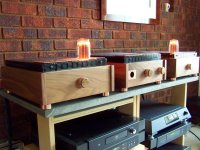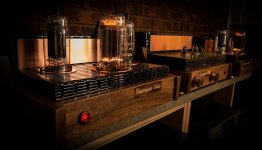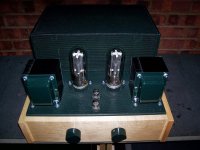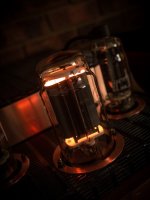One of the great benefits of listening to and reviewing audio is you get to hear a wide range of equipment. To be honest an awful lot of it is very competent. Occasionally you will come across some audio that is very good and stands out from the crowd. And more rarely you will come across some audio that hits the spot, appeals and sounds like real music. And very rarely there are the real gems, which also turn out to be reasonably priced. What our US colleagues call a game-changer. And if you could not guess this review is about a game-changer.
But first some back story. Many years ago, a few people whose ears I trust told me about what I call big valve Single Ended Triodes. Big valve (tube) SETs use 845, 211 or 805 triodes and they are as you can guess big. These audiophiles said big valve SETs amps had the magic of 300Bs but with real power and dynamics and have powerful bass. I said to myself, I must get to hear one.
Then there I was looking through the Classifieds of the Wam (recommended) and there it was, a lovely Mastersound 845 Compact integrated amplifier. It was reasonably priced so I bought it. I got it home and connected it into my reference system and what a sound. This amp had nearly all of the magic of 300Bs but with a more dynamic sound and deep bass. No, the bass did not match the tightness of the SS amp I had (Krell 600s) but it had that real flow you get with good valves. However, due to other audiophile itches, the Mastersound was eventually sold but its sound haunted me.
And then…… A good audio friend, Kevin Fiske, called me and said he was going to buy a new Big Valve SET from Audionote. After a lot of time I got his excited call, the new Tomei was here and now ‘burnt in’. He thought I might enjoy it. What an understatement. It was the best amplifier I had ever heard (not having heard an Ongaku in a domestic environment). It had all the 300B magic, deep tight powerful bass, brilliant 3D imaging and a huge amount of real musical detail. It was also big, heavy, hot and somewhat costly. Currently about £40K. Ouch.
My interest was rekindled. Audionote makes a less expensive 211 amplifier which was copper wired rather than the Tomei’s mixture of copper/silver. It looked the part. But…I spoke to the nice guys at Audionote. Do you get used ones often? Not really. How much……..faint…….. Currently about £20K.
Dash it.
Interest fades.
There are a few Chinese variants but I was nervous. What makes big valve SETs amps sound good is the design of the circuit, some expensive bits like the transformers, a big power supply and other expensive components. I got the chance to hear a set(?) of Consonance 211s when Kevin was reviewing them. I liked their sound and they were more reasonably priced at about £7K unless you buy them direct from China. Not keen on that risk. Tempt, tempt, I could hear them saying.
After a few months, I responded to a thread saying I was still interested in 211 amps but the costs were putting me off. Simonp/j of the Wam asked me if I had tried a Transcription Audio Progression 211 amplifier? Nope, not only that but I had never even heard of the company. But I would investigate.
The Progression Audio web page was informative but a bit sparse and had some nice pictures of great-looking amplifiers. A visit to Simon Robinson, the man behind Progression Audio, was arranged and off to sunny Cambridgeshire I went.
Simon R is an affable guy who has been making/designing 211 and GM70 amps for years. He has worked in major electronics companies mainly on very high-voltage circuits. However, his heart and soul were in making big valve SETs and in particular 211 amplifiers. He has since acquired a huge amount of experience in constructing these amplifiers and has tried all the variants of 211 amplifier design. He now knows what is important and it is the output transformers, the power supply, especially huge oil-filled capacitors and a simple circuit with point-to-point wiring.
The first thing that strikes you about his amps is they are heavy. When I say heavy, I mean HEAVY. The output transformers are 10Kg each and are made in Russia. His power amplifier weighs in at a very healthy 50Kg. The power supply is a humongous single block with huge capacitors made for big lasers in the US. Simon liked them so much that he bought the world’s supply of them.
The Progression amplifier comes in many variants of wooden case but the dark wood with a lovely copper top looks very seductive especially with the glowing 211 valves.
Of course, the plain boxes are less expensive and he had a varnished plywood encased power amplifier available.
So, after a visit to his workshop where all the magic happens, it was into his main room for a good listen. Oh my. Although we could not use his dCS CD system (ill CD transport) there was no doubt this was a great example of a 211 amplifier. After a few hours of listening, I asked the dreaded question. Can I listen to this amplifier at home? Sure. Half an hour later we loaded up the car and my Type R’s suspension sagged from the mass of the amp and off home I go.
When I got home, I had a problem, how do I get the amp out of the car? I can’t lift 50-odd Kg out of the car especially from a difficult lifting position. No, I can’t, no and I won’t do it. A quick call to my audio buddy, Bryan, (Bry-fi on the Wam) yea sure I’ll come around tomorrow with Alex, his lad (well a grown man actually).
Yes, I contained myself, just.
Anyway, Bryan and Alex turned up and before I could say thanks, they had it out of the car on its stand, on top of my Pass Labs XA30.8 power amplifier (Oh, the ignominy!!!). I had wired up the rest of the system, which was my AN CD4T, AN DAC 4.1x, AN M6 preamp, the Transcription amp and the AN Es. I connected the power amp and we sat down and let it warm up. After about 10-15 mins I put on a track to test that I had connected the channels correctly, got the balance right and nothing was amiss. All was good and correct. Bryan said they could only stay for one track. After 10 mins we put on a track of music and wow. There was the magic of SET 300Bs where each instrument, voice, effect was gently spotlit and it was easy to hear its contribution to the musical whole. It was a well-integrated sound. There was also a huge amount of musical detail. Unlike other amps, this detail was not highlighted or pushed at you due to various emphases of certain frequencies. Then there was the bass. It was tremendously deep, powerful and very tight. Tune playing was excellent. The soundstage was huge and became enormous as the amp warmed up, provided it was recorded in the music. I played another track and then asked what the guys thought. Alex noticed it getting warmer and the soundstage was opening up.
There were comments about it not sounding like valve bass, so on goes the usual bass test track from James Blake, Limit to Your Love. After the beginning of the track in comes the bass with some very deep synth tones in the mid-20Hz range. After that track finished, I asked the guys what they thought. Alex said the voices and instruments sounded very different from what he had previously heard as he knew the track well.
He said he was hearing more music than before. The bass was tight and pressurised the room. I then played an organ track by Guillou using the Tonhalle, Zürich organ. This track has deep bass that is more felt than heard. After about 10-12 tracks the guys had to leave. The amp worked really, really well in my system. A cracker and dare I say it, this amp could be a game-changer. Steady on though, what can be initially impressive can be less so on longer listening.
Time for some serious listening. The next day was free so a mammoth session was on the cards.
I let the amp warm up for an hour or so and then played my playlist of test tracks.
I started with big cinematic orchestral music including Hans Zimmer who includes studio effects to add drama and impact to his orchestral music. And what drama. Playing the theme tune to Batman, Why So Serious, the music starts quietly and then builds up in tension until it explodes into the room at 1:38 with some serious effects. And again at 2:30 with a crash, a bang and with real power. When these effects are added to the music it gives real tension to the theme. At 3:30 there is some deep synth bass that pressurised the room. This was serious (sorry?). Not heard it like this before and only from 18w of valve power!! OK onto something still slightly artificial but involving real instruments, the theme tune Medley from Game of Thrones by 2Cellos. The close miking captured the string tone of the cellos and the 211 amp played their real string tone. No thin sounds here. This track captured the midrange of the cellos and their power. The bass was powerful and full and the cymbals had great top-end sparkle with natural attack and decay. An amp’s ability to play warm bass and sparkling highs is what I call tonal dynamic range. These amps had it in spades but it is something which other amps have difficulty playing. The music builds throughout the track in intensity and ends leaving you tense; waiting for what comes next….the program.
What a start.
Something completely different. Ember by WhoMadeWho. Modern electronica with a big powerful driving bass, light vocals and a driving synth. There was real power here and in the middle of the track, the synth bass plays a prominent part which with weak bass or bass without the necessary clarity can make the track sound slow and lethargic.
There was none of that here.
On to Robert Plant and the boyz of Led Zeppelin. Dazed and Confused from their first album, which established what the band could do. The sheer power of Bonham’s drumming, Robert Plant unleashing the power in his voice and Jimmy Page’s great guitar playing give the song a powerful blues feel. There is some great interplay between John Paul Jones and Bonham at 2:20 that slows the track down and then starts to build it up until 03:30 when Bonham drives the track forward with Page adding a great guitar solo. At 05:00 Bonham drives the sound forward with some powerful drumming. I know the recording was not the best but there was some real raw power in the band in the early days.
Yes, but I had been playing tracks that showed off the big valve's power what about its subtlety?
Joan Baez’s album Whistle Down the Wind is a nicely recorded album with some fine singing. Joan’s singing is sublime with some great vocal intonation. What always previously seemed a little twee had some real emotion in it. And then on to Rhiannon Giddens and Birmingham Sunday (no, not Brummie). This has a nicely recorded piano and organ that blend well as she sings a song with a gentle sway. It sounds nice and pretty but it is about the bombing and murder of four women of colour with 22 others injured in a Baptist church in Birmingham USA. The song was written by Richard Farina and was originally sung by him and his sister-in-law Joan Baez. What a powerful rendition of the song. If you aren’t moved by this track check your pulse.
Onto more jolly stuff.
A test. I was present at a Mike Valentine recording at St Martins in the Fields where some rousing Beethoven 5th Piano Concerto was recorded. I played a track from this recording and it gave me the nearest I have been to being back in the church. And to keep with that theme, I then played a track from another Mike Valentine recording from Temple Church a few weeks ago featuring Justin Pearson on cello and Katherine Rockhill on piano. The instruments were very realistic and the acoustics of the church were superbly caught. Another back-to-the-scene recording as I was also there standing about a dozen feet from the microphones. This amp does realism.
Of course, I played a ton of music and whether it was live Black Sabbath, live Eagles, electronica of Eno, Emmerson, Lake and Palmer or some William Tell Overture this system was singing and I agree with a comment from Bryfiero, these amps work well with my Audionote system. I then forgot about reviewing the amps and just enjoyed my ‘new’ music collection.
Before I get too carried away there is better. I suspect the Audionote Jinro/Tomei are more refined but they are also more expensive.
In summary, these amps give you a huge chunk of the 211 experience. They are big, heavy and hot but that comes with 211 territory. And the sad news? Simon is thinking of retiring soon and will stop making these great amps. So, if you are after a great 211 amp, buy now or live in penance. Me, yep I bought this one.
And the best bit…..you can get one for £2200 to £6500!!!! Depending on the finish and whether you want a valve or solid-state rectifier or super components inside. Yes, they are not cheap but if you want a good 211 then you need big heavy components (expensive).
I recommend this amplifier as a game-changer.
Addendum: Can it get better? Yes. I have taken advice and ordered a set of Psvane 211 Acme valves from China. They will be here in a few days. And the word is they are a big improvement.
Can’t wait? Well, I have asked Simon p/j to write about his experience with his 211 amp and the different 211s he has tried. Over to Simon p/j.
To be Continued soon.
Last edited:






